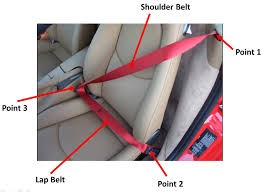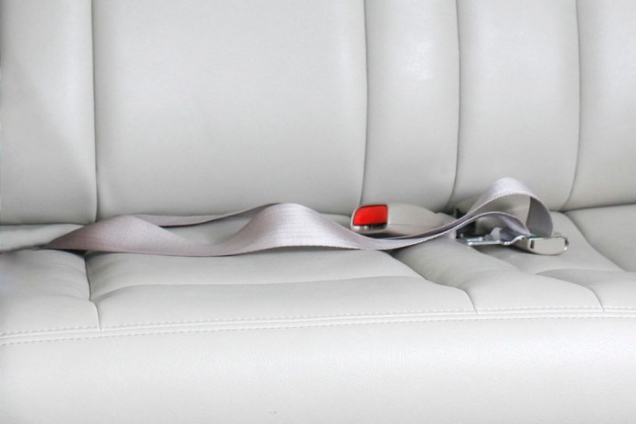Everyone who had secondary education learnt about Newton`s three (3) laws of motion.
The first law also known as law of inertia in particular states that “Everybody will continue in its state of rest or uniform motion in a straight line unless an external force acts on it to change that state”.
In a vehicle, the passenger literally moves with the same speed as the vehicle. It means that if the vehicle jerks/stops suddenly (external force applied), a passenger who is not “fastened/attached” to the vehicle will continue to move with the same speed in a straight line.
This may result in the passenger being thrown out of vehicle or hitting the windscreen in cases of accidents. Seat belt has been designed to “fasten or attach” a passenger to a vehicle to avoid the above danger in cases of jerk/sudden stops or accidents.
It is designed to exert an equal but opposite force on the person when the person moves against the seat belt in an accident according to Newton`s third law. This keeps the person with a controlled or minimum forward movement. A seat belt is one of the passive safety systems which reduces the effect of an accident. It has been described as the single most effective defence, the cheapest, most simple life insurance and the difference between life and death in an accident.
Seat belt
The creation of seat belts started in the late 1800s by George Cayley, an English Engineer and later by American Edward J. Claghorn. These earlier seat belts were largely two-point lap belts created initially for the safety of the lower parts of the body of pilots, tourist in vehicles and race vehicle drivers.
However, the invention of the current three-point seat belt in 1959 is credited to Nils Ivar Bohlin, a Swedish Volvo Mechanical Engineer. His invention was aimed at protecting both upper and lower parts of the body as well as being comfortable and easy to use.
Currently, there are two main types of seat belts in passenger vehicles namely a two-point/lap and three-point seat belt. However, four, five, six, seven et cetera point seat belts/harnesses exist for use in child safety, racing vehicles and air crafts.
A two-point/lap seat belt normally goes over the lap and wraps around the hip of the passenger. In a jerk, the passenger will remain seated, but there is high probability of movement of the upper part of the body. However, a three-point seat belt goes over the lap, shoulder and chest of a passenger. In a jerk, the passenger will remain seated with no or minimal movement in the upper part of the body.
The three-point seat belt is the preferred type of seat belt due to its effectiveness in the protection of driver and passengers. It has been seen as the most effective and innovative passenger safety system on vehicles in an accident. However, most vehicles do not provide the three-point seat belt for all occupants. For example, five-seater vehicles like a saloon or a pick-up provide four (4) three-point seat belts and one (1) two-point seat belt.


Vehicle manufacturers over the years have introduced systems to encourage seat belt usage. The smart seat belt reminder system uses warning lights or sounds as a reminder to occupants to wear their belts.

Many countries have made the wearing of seat belts compulsory due to its importance in saving lives. In Ghana, Road Traffic Regulations, 2012 (L.I. 2180) and Road Traffic Act, 2004 (Act 683) make it mandatory for vehicles to have seat belts for driver and passengers and must always be used.
However, many commercial vehicles popularly known as “trotro” do not have seat belts for most of the passengers. This is largely because such vehicles were not designed by manufacturers for passengers but have been “customised” locally for passengers. The construction, seating arrangement and seat materials are not appropriate and a hazard in cases of accidents. Hence the fitting of seat belts alone may not be enough to protect passengers in cases of accidents.
Furthermore, many drivers and passengers are reluctant to use seat belts due to several untenable reasons including not being comfortable, it is dirty, fear of being trapped in cases of emergency like fire et cetera. Many also quickly wear it due to the fear of the Police but remove it as soon they leave the Police. These confirm lack of knowledge and ignorance of the reasons and benefits of wearing seat belt.
Conclusion
Seat belt is considered among the most cost-effective road safety and public health intervention since it saved and continue to save millions of lives across the globe. The wearing of seat belt must therefore be taken seriously in Ghana due to several reasons including but not limited to:
- Proper wearing of seat belt keeps every one safe and secure in the vehicle.
- The severity of injuries and deaths are reduced by 50 per cent with the use of seat belt.
- It is the single most effective defence, the cheapest, most simple life insurance and the difference between life and deathin an accident.
- It is designed to function with air bags and other safety systems. In fact, the deployment of air bags may injure or even kill an individual in cases of accidents without the seat belt.
Recommendations
- The proper wearing of seat belts by every one including pregnant women and children at all times regardless of the distance to be covered. Parents and adults must lead and teach their children and young people by example according to Proverbs 22:6. However, children must be properly secured at the rear/back seats as provided by law.
- The importation of only vehicles particularly high occupancy and “trotro” buses fitted with mostly three-point seat belts into the country.
- Training and educational programmes and campaigns including games and educational entertainment (edutainment) by National Road Safety Authority (NRSA) and Driver and Vehicle Licensing Authority (DVLA) for Vehicle Dealers, Automobile Repair Workshops, Mechanics, Commercial Driver Unions, Organisations and public on the importance and proper wearing of seat belts.
- Organisations and individuals must ensure the purchase of vehicles with well-functioning three-point seat belts.
- Inspection of seat belts and its effective use by Motor Traffic and Transport Department (MTTD) and DVLA.
- National Insurance Commission (NIC) and Insurance Companies should also design educational programmes for insurance policy holders.
Latest Stories
-
PSG clinch Ligue 1 title after Lyon’s win over Monaco
8 mins -
Guinness Ghana sets the pace at Ghana Beverage Awards with six awards
29 mins -
Burkina Faso suspends BBC, VOA radio broadcasts over killings coverage
34 mins -
Nicole Kidman honoured with AFI Life Achievement Award
46 mins -
Brassier scores winner for Brest as they edge Rennes to secure European football
1 hour -
Ejisu by-election: Akufo-Addo jabs independent candidate; refutes allegations to rig elections
1 hour -
‘What are the real causes of the erratic power outages?’ GUTA demands from ECG
1 hour -
Implementing ESG framework in Ghana’s energy sector for sustainability
2 hours -
CAFCC: Dreams FC exit competition after 3-0 defeat in Kumasi
2 hours -
The detrimental effects of political interference on Ghana’s electricity sustainability
2 hours -
Prof. Opoku-Agyemang’s appointment as running mate intimidates the NPP – Benjamin Quashie
2 hours -
Black Stars physical trainer dead
2 hours -
Bawumia to kick off nationwide campaign for Election 2024 tomorrow
2 hours -
GUTA charges ECG to provide ‘dumsor’ timetable for businesses to plan
2 hours -
Reason for training professional counsellors is to heal a hurting world – CCP president
4 hours

